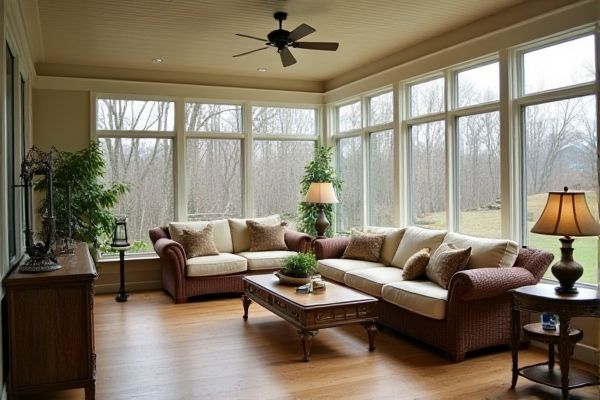
A sunroom offers a fully enclosed, weatherproof space with large windows that provide natural light and protection from the elements, while a screened porch allows fresh air circulation with mesh screens that keep insects out but offer less insulation. To decide which option best suits Your outdoor living needs, explore the full comparison in the rest of the article.
Table of Comparison
| Feature | Sunroom | Screened Porch |
|---|---|---|
| Purpose | Enclosed living space, year-round use | Outdoor space protected from insects |
| Structure | Fully enclosed with glass windows and walls | Open frame with mesh screens |
| Climate Control | Heated and cooled like interior rooms | No HVAC, natural ventilation only |
| Weather Protection | Complete protection from rain, wind, and cold | Protection from bugs and light rain only |
| Cost | Higher installation and maintenance costs | Lower cost, simpler construction |
| Materials | Glass, insulated walls, solid framing | Wood or metal framing, mesh screens |
| Usability | Usable in all seasons | Best for mild weather seasons |
Understanding Sunrooms and Screened Porches
Sunrooms are fully enclosed spaces with glass walls and roofs designed to capture natural light while providing protection from weather and insects, making them ideal for year-round use. Screened porches feature open frameworks covered with mesh screens that allow airflow and outdoor views while keeping bugs out, suitable for warmer seasons. Choosing between a sunroom and a screened porch depends on climate, intended usage, and preferences for ventilation versus insulation.
Key Differences Between Sunrooms and Screened Porches
Sunrooms are enclosed spaces with large windows, allowing for year-round use and protection from weather, while screened porches feature open-air designs with mesh screens that provide ventilation and keep insects out. Sunrooms often have insulation, glass walls, and climate control options for comfort in all seasons, whereas screened porches are ideal for enjoying fresh air and natural surroundings during warmer months. Your choice depends on whether you prioritize weather protection and year-round use (sunroom) or outdoor ambiance and airflow (screened porch).
Climate Control and Comfort Features
Sunrooms offer superior climate control with insulated walls, windows, and often HVAC integration, allowing year-round use regardless of external weather conditions. Screened porches provide ventilation and protection from insects but rely on outdoor temperatures, making them less comfortable during extreme heat or cold. Your choice depends on whether you prioritize controlled indoor comfort or a more open, natural experience.
Cost Comparison: Sunrooms vs Screened Porches
Sunrooms generally cost between $15,000 and $70,000 depending on size, materials, and customization, while screened porches typically range from $10,000 to $30,000. Sunrooms require more investment due to insulated glass, framing, and often HVAC integration, offering year-round usability. Screened porches provide a budget-friendly option for outdoor enjoyment but lack the weather protection and energy efficiency of sunrooms.
Construction and Installation Requirements
Sunrooms typically require a more complex construction process involving insulated glass panels, roofing, and a sturdy foundation to ensure year-round usability and energy efficiency. Screened porches are simpler to install, using lightweight framing and mesh screens for ventilation and insect protection, often relying on existing porch structures. Your choice depends on whether you want a permanent, climate-controlled space or a more open, economical outdoor area.
Durability and Maintenance Considerations
Sunrooms constructed with glass and sturdy framing materials offer superior durability against weather elements compared to screened porches, which typically use lighter mesh screens prone to tearing and require more frequent replacement. Maintenance of sunrooms generally involves cleaning glass panels and occasional inspection of seals to prevent leaks, while screened porches demand regular screen repairs and debris removal to maintain airflow and appearance. Your choice between the two should consider not only daily upkeep but also long-term resilience to ensure the structure meets your lifestyle needs.
Year-Round Usability and Seasonal Benefits
A sunroom offers year-round usability with insulated windows and walls, providing protection from cold winters and hot summers, ensuring comfort regardless of the season. A screened porch, on the other hand, is ideal for mild weather, offering ventilation and protection from insects but lacking insulation for colder months. Your choice depends on whether you prioritize continuous use or seasonal outdoor enjoyment.
Aesthetic Appeal and Design Options
Sunrooms offer versatile design options with large glass panels that create a bright, open aesthetic ideal for year-round use and panoramic views. Screened porches emphasize an airy, casual feel, using mesh screens to blend indoor comfort with outdoor ambiance while protecting against insects. The choice between a sunroom and a screened porch depends on desired light, weather protection, and integration with home architecture.
Impact on Home Value and Resale
A sunroom typically increases home value more significantly than a screened porch due to its year-round usability and enhanced living space, often attracting buyers looking for added comfort and versatility. Screened porches provide functional outdoor enjoyment but may have a more modest impact on resale value because of limited weather protection and seasonal use. Your investment in a sunroom can yield higher returns by appealing to a wider market seeking both natural light and shelter.
Choosing the Right Option for Your Home
Selecting the ideal sunroom or screened porch depends on your climate, lifestyle, and budget. Sunrooms offer year-round comfort with insulated glass and HVAC options, making them suitable for colder regions, while screened porches provide more airflow and insect protection at a lower cost. Consider your home's architectural style and how often you plan to use the space to ensure maximum functionality and value.
 homyna.com
homyna.com